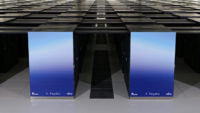ARM-Based Japanese Supercomputer Now No. 1 on Top500
June 24, 2020
While the United States and China compete to create the world’s most powerful computers, a Japanese supercomputer, dubbed Fugaku, took first place in Top500’s speed ranking. At the Kobe-based RIKEN Center for Computational Science, Fugaku achieved 2.8 times more calculations per second than the previous speediest system, IBM’s at Oak Ridge National Laboratory in Tennessee. Fugaku, which pushed another IBM computer at Lawrence Livermore National Laboratory in California to third place, is based on ARM chip technology.
The New York Times reports that supercomputers in China “moved to the fourth and fifth spots from third and fourth.” RIKEN revealed that Fugaku (another name for Mount Fuji) is “already being used to help study, diagnose and treat COVID-19.” In the Top500 list of fastest supercomputers, China has 226 systems and the U.S. has 114, which represent “a greater share of aggregate computing power.”

Japan has never been a major player in supercomputing but it held the No. 1 spot on the Top500 list in 2011 with its K computer, also out of RIKEN. The system from Livermore knocked it off that spot the following year.
Lawrence Berkeley National Laboratory deputy director of research Horst Simon, who studied Fugaku, said it is a “very remarkable, very admirable” supercomputer. But, he added, it is likely to be knocked off its perch soon by “forthcoming Department of Energy systems at Oak Ridge and Livermore and likely advances in China.” Fugaku’s six-year budget was “about $1 billion, compared with the $600 million price tags for the biggest planned U.S. systems.”
The system is also noteworthy for the fact that RIKEN’s partner Fujitsu licensed designs from ARM, owned by Japanese company SoftBank. Bloomberg reports that, “by contrast, most supercomputers use microprocessors that evolved from the chips that Intel and Advanced Micro Devices first sold for PCs.”
ARM senior vice president Christopher Bergey noted that Fugaku “is the culmination of almost 10 years of investment and work.”
Engadget reports that this is “the first time a system with ARM processors has debuted on the number one spot on the list.” Fujitsu licensed ARM design to create a 48-core A64FX system-on-a-chip; 158,976 of these chips enabled Fugatu to achieve “a benchmark of 415.5 petaflops and a peak performance of 1 exaflop.”
It adds that, “x86-based systems featuring processors made by Intel and AMD have been the most common sight on the Top500; only four ARM-based supercomputers appear on the current list.”
Fugaku also “doesn’t include any dedicated GPUs to help with artificial intelligence applications.” It reports that AMD is working with Cray to build a 1.5 exaflop system for the Department of Energy and Oak Ridge National Laboratory and “is also making an Intel-based exascale system for the Argonne National Laboratory,” both slated to be unveiled in 2021.

No Comments Yet
You can be the first to comment!
Sorry, comments for this entry are closed at this time.